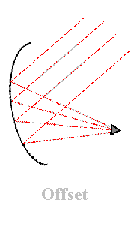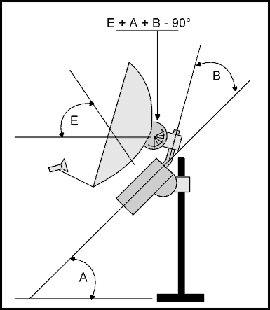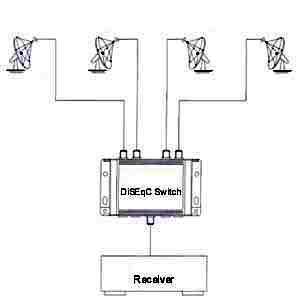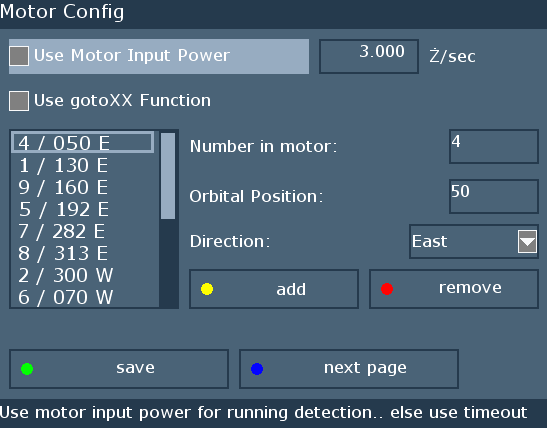Dish Positioning
For optimal reception, you need a strong satellite signal.
Setting up a satellite antenna (AKA dish) to receive a single satellite is quite
simple. Things get more complex if you want multiple satellites, and having
a motorized dish is a major pain in the a**.
For starters you need a strong vertical anchor point, with
a clear view to the satellite(s) you want to receive. Satellite reception needs
a visual line of sight, so if a house stands in your way, you're out of luck.
If it's a tree, ask the owner if you can cut down a few leaves. Clouds, fog,
rain and snow are not so much of a problem, but they still tend to degrade the
signals somewhat,
 |
There are two types of dishes : Prime Focus dishes are
mainly used for C Band reception, and Offset dishes are mainly used for
Ku Band reception. Offset dishes are good to receive satellites from different
positions at the same time, as it is not possible to point a dish to two
positions at the same time.
The dish has to be pointed in the general direction of
your satellite(s). In most European countries, the dish has to be mounted
at 45° elevation, pointed to the south.
Check the lyngsat
Site for more information on satellite tracking in function of your
geographical position.
|
 |
I am going to use an Offset dish. You can find the proper elevation
angle for your dish on on Autoroute Express (or the
IGN site for France, or this
site for Rest of the World) in function of your exact longitude/latitude,
(48,85786N 2.29504E in my case :-) You can of course also use a less precise
value. The Lyngsat
site offers a nice tool to find all needed information with only one or
two clicks.
For me, on Astra, I need :
Elevation : 32.23°
azimuth: 158.47°
For a simple dish, or for a multiple LNB systems (several dishes
with one LNB each or one dish with several LNBs), elevation is all you need.
So set up your dish as precisely as you can
 |
For Motorized satellite dishes it is more tricky:
You first have to locate the south, and then put your motor at zero degrees
for that position. The dish needs to move along the satellite arc,so you
have 2 angles to set up. One is the global angle, the second is the motor
angle. Refer to the documentation of your motor to get more details about
those two angles and how to configure them.
First, try to get a satellite near the south, like Intelsat 707 1°W.
Note that 1°W is only a marketing name, and the real value depends
on your geographical position.
|
In the Dreambox itself, if you're not using a motorized system, configure a
single dish without DiseqC to locate the first satellite, then start configuring
DiseqC to find additional satellites.
Here is a standard configuration :

At the first boot, you need to choose your language, Time Zone and then your
dish configuration, from basic one LNB/One dish, Medium with several LNB/Dishes
with DiseqC switching, or complex with a motorized unit. So, pick your settings
and you will reach the following screen:

For a motorized dish, you could enable the gotoXX Function which is
a way for the Dreambox to tell the motor to go to a certain position. However,
not all motors support this function, and even if it is supported, it doesn't
necessarily work properly. A better way to use the motor is to uncheck Use Motor
Input Power, and use 1°/sec ( I have 2.250 on mine, but you will improve
that later on) and uncheck Use gotoXX Function. Then press the blue button,
select Astra, Hotbird or Intelsat 707. Then click on the green button to save
your settings, and on the blue one to reach the next screen :

Then select a transponder that actually broadcasts TV 24/7. You can get a list
of transponders from lyngsat.
Personally I used:
HB : 11304 27500 H
Astra : 11156 22000 V
i707 (1West) : 11229 24500 H
Hispasat : 11226 27500 V
Sirius : 11766 27500 H
The SNR level is the "Signal-To-Noise Ratio", or the relation between
signal and noise level. The higher the SNR, the better the signal. AGC is Automatic
Gain Control, but this is of no concern to us. BER is the Bit-Error Rate. The
lower this value, the better the reception. When you receive a signal on the
currently selected frequency/Bitrate/Polarisation, the two checkboxes LOCK and
SYNC will be checked. Good signals have an SNR of 80+%, AGC 55 and a BER of
zero. 65% SNR is already rather low, and if your BER isn't at zero, you'll get
a frozen picture from time to time, or no picture at all.
Once you manage to receive a signal from one satellite, optimize the signal
by slowly moving the screws on your dish to optimize the position, then use
the east/west function to fine-tune. For a single satellite installation, that's
all there is to it. If you have multiple LNBs, try to find a good signal by
changing the dish position, then optimize by changing the LNB position.
For a motorized system, try to receive a signal from two other satellites.
If you cannot get a signal from other satellites (as an example Astra 19.2 or
Hispasat), then your dish is probably not properly set up. Your motor zero position
is probably not really facing south, or your curve settings are not right. If
you manage to receive two other satellites, you can optimize the reception as
follows:
Point your dish to Hispasat, then slowly turn the screw to optimize the reception.
Write down the optimal position (for instance: 2 turns to the left), then get
back to the original setting and do the same for Astra 28.2 (that's almost the
same position but to the east rather than the west). Based on those values you
can now determine the best course of action:
If you wrote down the same value for both satellites (for instance 3 turns
to the left for Astra, 3 turns to the right for Hispasat), your dish is not
mounted vertically or the motor is not zeroed properly (pictures 1 & 2).
If the direction of the screw turns is the same for both satellites, your curve
arc is not perfect and you have to change the motor tube angle.
Here are the different errors you can have, but you can mix them !
Once the optimization is done, you should be able to receive a strong signal
from every satellite. It's generally a good idea to optimize the dish position
for less powerful satellite. The author, who lives in Paris, prefers to optimize
using Sirius on 11804 27500 H (Nordic spot)
Once optimized, you should not have any problems receiving a good signal from
more powerful satellites like Astra, HB, Hispasat, etc. Keep in mind that not
every satellite can be received everywhere. Satellites over the United States,
or Africa are impossible to get in Europe. Lyngsat
will also tell you about the reception area for each satellite.











